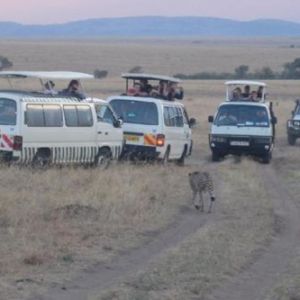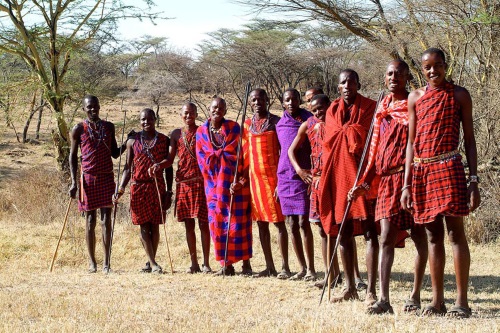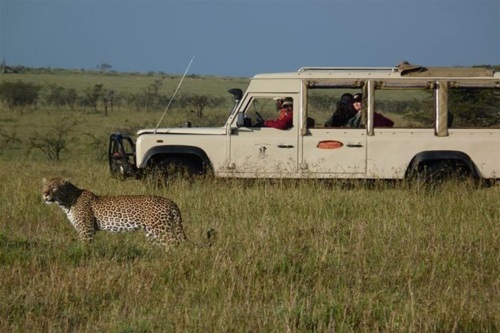Conservancy Concept
Sustainably marrying wildlife, community & tourism
3 Key Elements of the Conservancy Concept
Environment, Community, Tourism
The 3 key elements of our conservancy concept, how these are linked together and are making a difference in the conservation of the Mara for the long-term:
- ENVIRONMENT
Stopping the degradation of the Mara eco-system, reversing the decline in wildlife, increasing bio-diversity, allowing recovery of wildlife habitat, conserving the wild animals, birds and plants. - COMMUNITY
Giving the Maasai landowners genuine and meaningful benefits from allowing their lands to be used for wildlife conservation. - TOURISM
Creating a new form of tourism that gives our tourist industry a real boost by providing a better experience for visitors and which avoids the high-density minibus safari for which Kenya has often been criticized.
These 3 aspects have been described as the “triple bottom line” – providing benefits or profits for the environment, for local people, and for the private sector safari companies.
Working with the Maasai landowners, Gamewatchers Safaris pioneered the creation of community-owned wildlife conservancies, starting with Ol Kinyei Conservancy in 2005 and followed by Olare Orok, Motorogi and most recently Naboisho Conservancy.


Environmental Issues
Negative Trends – Declining Wildlife
Some statistics:
- Populations of wildlife species in the world-renowned Maasai Mara reserve in Kenya have crashed in the past three decades, according to research published in the Journal of Zoology.
- Dr Joseph Ogutu, a Kenyan statistician at the University of Hohenheim, Germany conducted the study with colleagues there and at the International Livestock Research Institute in Nairobi, Kenya. The team looked at data gathered since aerial monitoring of Kenya’s wildlife began in 1977.
- This covered 12 species of large mammal, ostriches and livestock, and allowed the team to calculate trends in wildlife numbers over a 33-year period across the entire reserve, and in the Maasai pastoral ranches adjoining the reserve.
- Numbers of impala, warthog, giraffe, topi and Coke’s hartebeest in the Mara eco-system have declined by over 70%, say the scientists. Beyond the reserve in the wider Mara, buffalo and wild dogs have all but disappeared, while huge numbers of wildebeest no longer pass through the region on their epic migration.
Scientists report huge decline in wildlife in Mara
- There appear to be three main causes of these dramatic declines: the activities of poachers, changing land use patterns in ranches within the Mara eco-system, and an increase in the numbers and range of livestock held on these ranches.
- According to Dr Ogutu, over 1500 poachers have been arrested within the Mara conservancy between 2001 and 2010, with more than 17,300 snares collected by rangers in the same period.
- “Poaching continues to be a major menace,” he says.
- However, numbers of cattle grazing in the reserve have increased by more than 1100% per cent, although it is illegal for them to so do.
- This explosion in the numbers of domestic livestock grazing in the Mara region of south-west Kenya, including within the Maasai Mara national reserve, is one of the principal reasons wildlife has disappeared, say the scientists who conducted the research.
Reasons for wildlife decline:
- HABITAT LOSS ON COMMUNITY-OWNED LANDS OUTSIDE RESERVE (cultivation, intensive ranching, settlements, charcoal, forest clearance)
- POACHING AND KILLING OF WILDLIFE INSIDE AND IN AREAS BEYOND THE RESERVE
- OVER-GRAZING: TOO MANY COWS, SHEEP, GOATS
- OVER-DEVELOPMENTS BY THE TOURISM SECTOR: HIGH-DENSITY TOURISM
Tourism Issues
Over-Development
Concerns about negative aspects.
Over developments within the Mara Reserve and ribbon development along the boundaries and near the gates especially in Talek, Sekenani, Siana resulting in high density tourism.
There was only 1 lodge and 100 beds in the 1960s – but over 160 camps and lodges and over 7,000 beds by August 2011.
Within the Mara Reserve there has been over-development of tourist facilities resulting in too many vehicles crowding the animals and spoiling the visitor experience
Positive Effects of the Conservancy
Environment, Community, Tourism
ENVIRONMENT
- No more over-grazing in the conservancy.
- No sedentary homesteads or livestock bomas in the conservancy.
- Grass and vegetation recover.
- Rainfall increases over the conservancies! Micro-climate…
- Virtually no poaching or wildlife killing within the community-owned conservancies.
- Presence of warden and rangers to protect wildlife in the conservancies.
COMMUNITY
- Payments received directly by individual landowners, NOT via a committee with a chance of money going astray.
- Employment opportunities for landowner families.
- Land improves, vegetation and grass regenerate, no tree-cutting or plowing.
- Continued ownership of land by the individual title deed holder.
- Involvement/participation of landowners
- Koiyaki Guiding School: training for school-leavers who can have a career in their conservancies.
The camp staff, guides, and conservancy rangers are all drawn from the families of the Maasai landowners
TOURISM
- The camps, small authentic bush camps:
Porini Lion Camp in Olare Orok Conservancy: 10 guest tents,
Porini Mara Camp in Ol Kinyei Conservancy: 6 guest tents. - The type of tourism – small scale, emphasis on guiding and the safari experience.
- Eco-friendly – energy, sewage, and refuse disposal are all certified by Ecotourism Kenya and the camps have silver certification.
- Wildlife viewing without the crowds of minivans
- Guiding by Maasai guides – KPSGA bronze and silver guides
- Excellent Customer feedback – Number 1 on TripAdvisor!
Guest Testimonials

“What a marvellous example of how people and wildlife can live alongside one another. Thank you all.”
“For any serious wildlife photographer, I don’t think you can do better in Kenya or Tanzania than the Porini Mara and Lion Camps for the big cats.”


















